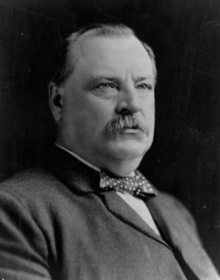Search This Blog
Sunday, April 15, 2012
Grover Cleveland 2.0
Served as president from 1893-1897
Era: Gilded Age
American Identity and Culture
During the years 1983 to 1897 there were many new advancements in the American culture. For example, the author H.G. wells made a new novel that piqued the interest of many Americans. He made the new novel The Time Machine. This was a science fiction novel that was published in 1895 and it brought out many new ideas in the scientific world, questioning many controversial theories that were here during this time. There were also scientific advancements in the world such as the discovery of x-rays in the atmosphere. Wilhelm Rontgen was able to discover that there were x-rays in the world in the year 1895. This new ray changed science because it later adapted the X-ray to see through the human body and also the ideas of radiation in America and the world.
Economic Transformations and Globalization
During Cleveland’s presidency, the nation entered a severe depression and nearly eighteen percent of its workers were unemployed by 1894. One response to this was the creation of Coxey’s Army, a group of unemployed workers marching to Washington D.C. in an attempt to force the government to provide public works projects and relief. The march was unsuccessful because it did nothing to change Cleveland’s mind (he did not believe that it was the government’s duty to sponsor work projects to relieve the depression). Labor unrest continued and erupted when railroad workers all over the country struck in support of the Pullman Strike where workers walked off from a company town in Chicago. In response, he sent in federal troops to enforce an injunction against the striking railroad workers.
Environment
During President Cleveland’s second term of presidency, Cleveland helped to admit the state of Utah to joining the union by persuading the Congress to pass the Enabling Act of 1894. The act allowed Utah to request statehood and thus in January 1896, Utah was admitted into the union.On a more personal level, President Cleveland disliked the amount of Chinese in the United States and thus liked the Chinese Exclusion Act. President Cleveland believed that the Chinese race and cultural was just too different from the traditions of Americans and for this reason, President Cleveland sought to reduce the amount of Chinese immigrants in the United States. President Cleveland also disliked the Native Americans. He believed that the Native Americans were subjects to the United States and that they needed to be treated like children. In 1887, President Cleveland signed the Dawes Act of 1887 which gave him the power to give land in the reservations to Indians.
Politics and Citizenship
Cleveland was concerned with the political situation in Hawaii. In his fear of American sugar planters and the Harrison administration’s involvement to overthrow the Hawaiian monarchy, Cleveland attempted to pressure its revolutionary government into handing power back over to Queen Liliuokalani. Cleveland handed the problem over to Congress after American sugar planters threatened to resist violently and the Queen refused to provide the revolutionary leaders with amnesty and insisted on beheading them instead.
Slavery and its legacies in North America
In America there was a landmark case known as the Plessy v. Ferguson case. In this case the Supreme Court had upheld the constitutionality of a law in Louisiana that required the segregation of African American Passengers and White Passengers on Railroads. The African American people would be required to enter “separate but equal” accommodations on the railroads in Louisiana. The Supreme Court rules that this law was not in violation of the Fourteenth amendment that states that all people in America are guaranteed equal protection. After this, due to the court decision, the Jim Crow Laws came to be. These laws were adopted by Southern states and these required the segregation of public facilities like bathrooms, drinking fountains, park benches and lots more.
War and Diplomacy
In 1893, the Hawaiian population planned to overthrow Queen Liliuokalani because they deemed her as a tyrant since she would not accept the idea of a constitutional government. As a result, the Hawaiians asked the United States to promise to help and provide protection to them. When President Cleveland was asked whether or not to annex Hawaii, President Cleveland adamantly rejected theannexing Hawaii. To further support his decision/words, President Cleveland ordered for Hawaii to remove the flag of the United States from their territory. Despite the fact that President Cleveland supported free trade with Hawaii during his first term as president, President Cleveland encouraged the United States to practice non-intervention in foreign affairs. However as Congress showed Cleveland the Morgana Report which proved the findings of James Henderson Blout (his findings showed that the American public did not want Cleveland to annex Hawaii) false, President Cleveland took back his words of reinstating the Queen back to her position and acknowledge the Republic of Hawaii.
Subscribe to:
Post Comments (Atom)

No comments:
Post a Comment